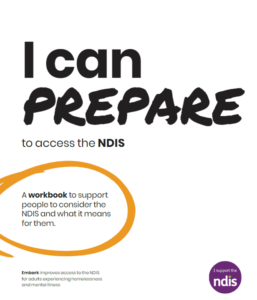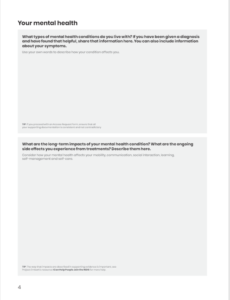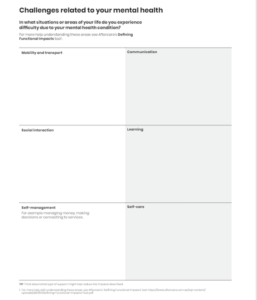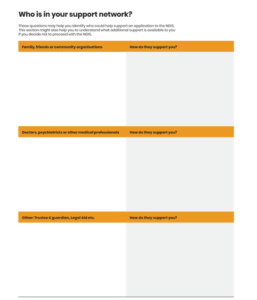
Thanks for joining us in our Embark blogpost series, where we share some of our tips for supporting people to access the NDIS. Embark provides support to people with disability living in the Sydney Metropolitan area that are living with a mental health condition and experiencing (or at risk of) homelessness, to access the NDIS. [You can make a referral to our free service via: www.icla.org.au/embark/]
You can also get in touch for support – via Embark Upskill, we facilitate free workshops across NSW, open to anyone who wants to improve their confidence and understanding of the NDIS in order to support people with a mental illness to access the NDIS and obtain the supports they need. [Make an enquiry via: www.icla.org.au/embark/upskill]
Beginning the journey to access the NDIS may seem confronting, difficult, and extremely time-consuming at first glance. However, Embark have created a useful resource that will hopefully assist you from the beginning and guide you in all the right steps to ensure that you are off to the strongest start possible!
Embarks ”I Can Prepare” Booklet is a workbook that aims to support people to understand the NDIS and consider how it might apply to them personally. The workbook is designed to help people with disability and their supporters to start thinking about the NDIS and assess whether they might be eligible and interested in submitting an application.


I like to break down the NDIS access procedure into two simple points.
- Prove permanence – and that available and appropriate treatment options have been tried. .
- Outline and evidence ‘reduced functional capacity’ – (For the purposes of NDIS applications – Functional capacity is what the person can, or could do, not what the person chooses to do or what others do for the person
The first few pages of the workbook explain how it can be used by a person with disability to get a sense of their eligibility for the NDIS.
Above is page 4 of the workbook, which gets a person to reflect on their mental health. This can either be completed independently by the person wanting to access the NDIS themselves, or in discussion with a support person.
This is where you would ask the person to look at how their mental health condition impacts them in their day-to-day life. In the first box you can record any diagnoses (they have any) and their symptoms. Remember – we don’t necessarily need a diagnosis to apply for NDIS – just try to write down and explore all of the symptoms that the person experiences.
In the second box you should discuss how a person’s mental health condition has affected them long-term – this is critical in evidencing that a person’s disability is lifelong, or likely to be lifelong.
Now page 5 asks about a person’s treatment history. Remember, an important part of the application for the NDIS needs to prove that a person’s disability is likely to be lifelong. This section helps to identify that treatments have been tried and assists with starting to evidence that further treatment is unlikely to resolve the condition.

The table on page 6 discuss how the person’s condition impacts them in their day-to-day life. Use the 6 areas of functional capacity outlined in the table to explore what areas of life the person experiences the most difficulty.
As an example, you could record how the symptoms discussed previously prevent a person from making or keeping friends or relationships, which would fall under ‘social interaction’. Or how their symptoms prevent them from managing their medication, which would fall under ‘self care’.his helps to start building a broad picture ofthe person’s disability, and therefore starts to translate the medical language that doctor’s use to describe mental health conditions into the language of disability used by the NDIA.
NB: these 6 areas are the DIRECT areas that the NDIA look for proof of impairments – it’s important to really identify everything and anything that you can that would fit in these 6 areas – Mobility, Transport, Communication, Social interaction, Learning, Self-management and Self-Care so you are speaking the same language as the people the NDIA assessing the application.

On Page 7 we start to talk about a person’s goals.
Discussing goals early on with someone thinking about applying for the NDIS helps to identify how the NDIS could be relevant to them.
Talking about goals is also a good way to somewhat counteract the deficit-based and generally negative nature of the NDIS access journey and allows you to have a more positive discussion.
These goals don’t need to be perfect or set in stone
, they just need to start building a picture of what the person could get out of NDIS. Ideally these goals should be open ended and broad, as broad goals have the best chance of being applied to the broadest range of funding that can be received from the NDIS.

On Page 8 we find it useful to talk to the person we’re supporting about who is in their support network.
Family, friends, community groups, churches, teams, and all sorts of supports! Most importantly, treating healthcare clinicians.
This can help to identify people who could assist with a NDIS application, by writing supporting letters, or supporting the person to attend doctors’ appointments to collect supporting evidence, or as a general support to assist with the journey. This also allows you to spot where to go for to obtain further supporting evidence – the more the better! 🙂
This workbook can be found here – Or feel free to browse our other useful tips and tricks on ICLA’s website here – https://icla.org.au/news-resources/
Thanks again for joining us. Please be in touch with any questions or suggested topics for future content via embark@icla.org.au.
ICLA’s Embark program is funded by the NSW Ministry of Health to support people with a mental health condition who are experiencing, or at risk of, homelessness to access the NDIS.


Recent Comments